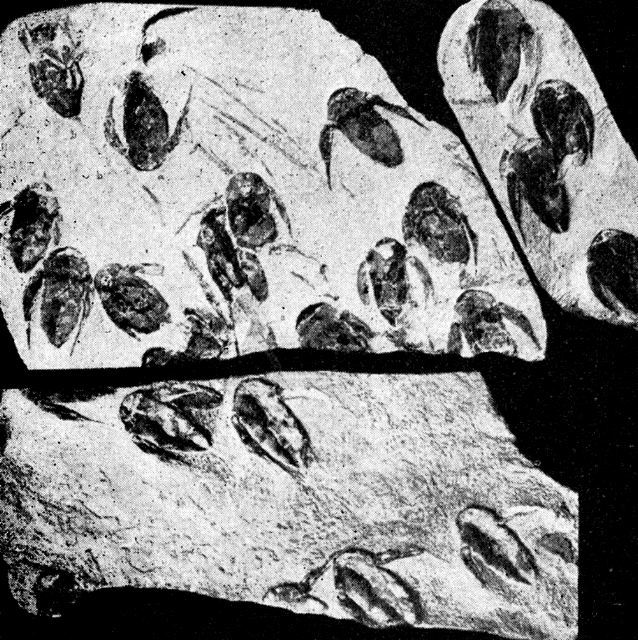Specimens by the thousands
The fossils of the Escuminac Formation are both abundant and exceptionally well preserved. There are so many fossils in the rock layers that even simple erosion of the cliff by rain or springtime that causes them to fall onto the beach below like ripened fruit from a tree.
 (140 kb)
(140 kb)
More than 17,000 vertebrate, invertebrate and plant specimens have been extracted from the cliff since the first official digs in the summer of 1879. About 10,000 of these specimens can be found in the collection of the Natural History Museum at the Parc national de Miguasha. The rest are scattered throughout thirty or so research centers, museums and universities across Canada and throughout the world.

 (80 kb)In terms of numbers, the placoderm Bothriolepis canadensis is the best represented, accounting for 28% of the 10,000 specimens in the museum, making a veritable Bothriolepis sanctuary! Even Eusthenopteron, a very rare fish, is well represented, with 1,600 specimens as of 2006. And some of the rock layers are exceptionally fossil-rich, even by Miguasha standards, with up to 600 specimens of the small acanthodian Triazeugacanthus affinis per square meter!
(80 kb)In terms of numbers, the placoderm Bothriolepis canadensis is the best represented, accounting for 28% of the 10,000 specimens in the museum, making a veritable Bothriolepis sanctuary! Even Eusthenopteron, a very rare fish, is well represented, with 1,600 specimens as of 2006. And some of the rock layers are exceptionally fossil-rich, even by Miguasha standards, with up to 600 specimens of the small acanthodian Triazeugacanthus affinis per square meter!
The sheer abundance of fossils at Miguasha is obviously extraordinary. In fact, a site like this can be considered a “quasi-renewable” fossil resource in the sense that only a small fraction of the rock formation has been excavated and new outcrops have been discovered inland in recent years. What treasures do future excavations have in store for us?

 (140 kb)
(140 kb) More than 17,000 vertebrate, invertebrate and plant specimens have been extracted from the cliff since the first official digs in the summer of 1879. About 10,000 of these specimens can be found in the collection of the Natural History Museum at the Parc national de Miguasha. The rest are scattered throughout thirty or so research centers, museums and universities across Canada and throughout the world.

 (80 kb)In terms of numbers, the placoderm Bothriolepis canadensis is the best represented, accounting for 28% of the 10,000 specimens in the museum, making a veritable Bothriolepis sanctuary! Even Eusthenopteron, a very rare fish, is well represented, with 1,600 specimens as of 2006. And some of the rock layers are exceptionally fossil-rich, even by Miguasha standards, with up to 600 specimens of the small acanthodian Triazeugacanthus affinis per square meter!
(80 kb)In terms of numbers, the placoderm Bothriolepis canadensis is the best represented, accounting for 28% of the 10,000 specimens in the museum, making a veritable Bothriolepis sanctuary! Even Eusthenopteron, a very rare fish, is well represented, with 1,600 specimens as of 2006. And some of the rock layers are exceptionally fossil-rich, even by Miguasha standards, with up to 600 specimens of the small acanthodian Triazeugacanthus affinis per square meter!The sheer abundance of fossils at Miguasha is obviously extraordinary. In fact, a site like this can be considered a “quasi-renewable” fossil resource in the sense that only a small fraction of the rock formation has been excavated and new outcrops have been discovered inland in recent years. What treasures do future excavations have in store for us?
Site map | Feedback | Links | Sources | Credits
Specimens by the thousands
<< Fossil quality | The food chain >>

Title: Rock layers containing many Bothriolepis specimens
Author: William Patten
Sources: Patten, 1912
Year: 1912
Description:
The rock layers in the Miguasha cliff contain scores of fossils. This particular example, discovered by the American paleontologist William Patten, reveals a population of the placoderm Bothriolepis. The image is taken from Patten’s 1912 book “The Evolution of the Vertebrates and their Kin” (Figure 257).



